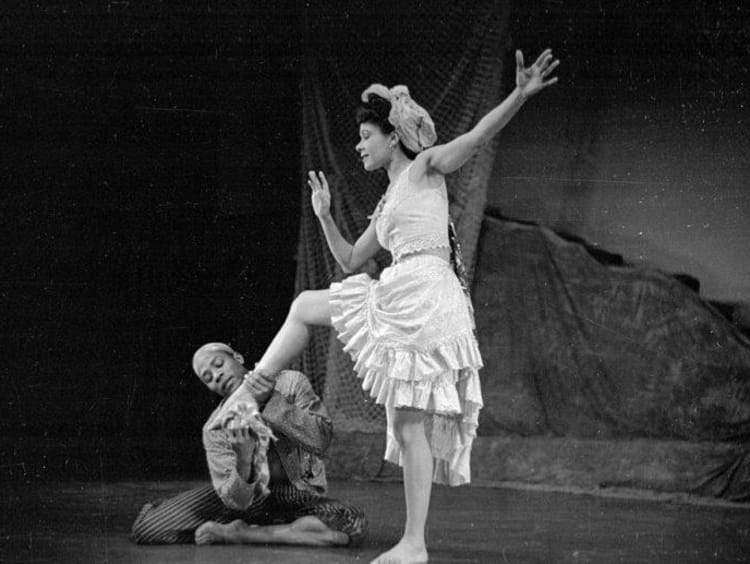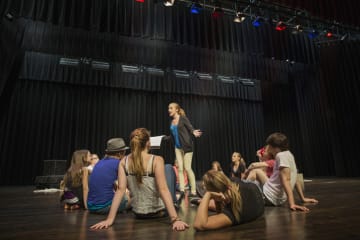Who Is Katherine Dunham?

Katherine Dunham was an African-American dancer and choreographer, producer, author, scholar, anthropologist and Civil Rights activist. She had one of the most successful dance careers in Western dance theatre in the 20th century and directed her own dance company for many years.
She is known for her many innovations, one of her most known being the Dunham Technique, a system of movement and exercises based in traditional dances of the African Diaspora. She passed in 2006 at the age of 96, but she has left a lasting legacy in the dance world.
Who is Katherine Dunham?
Katherine Dunham founded the first American black dance company and opened her own school of dance in New York in 1944. In 1946 the school’s name changed to the Katherine Dunham School of Arts and Research to reflect that the curriculum included the arts, languages and the humanities. On top of it all, she became the first black choreographer at the Metropolitan Opera in New York City. Her school was an influential center of black dance that welcomed all. In fact, many actors were eager to learn from her experience and attend one of the best most prestigious schools of its time. Among her students were Gregory Peck and Shirley MacLaine as well as many other actors and celebrities. In one famous photo, James Dean is seen dancing behind Eartha Kitt, who was a member of Dunham’s company.
She has a long list of accomplishments that stretch further than just performance. An author of at least nine books and countless articles, she also had an extensive list of activist work from refusing to perform in the segregated theaters to going on a 47-day hunger strike protesting the inhumane treatment of the Haitian refugees in 1992 when she was in her eighties.
Social Activism
Dunham spent much of her career standing up for those who did not have a voice. In the mid-1940s her company was on tour in the racially segregated South. She refused to hold a show at a theatre after learning that the African American residents were not allowed to get tickets for the performance.
During another performance in Kentucky in 1944, she told the all-white audience that her company would not be coming back because the management of the theatre would not let blacks sit with the whites.
On the West Coast in Hollywood, Dunham refused to sign a contract with a studio when the producer expressed that she would need to replace some of her dancers. Her company also found it difficult to find stay where they toured because many hotels didn’t allow African Americans despite the fact that it was not subject to the Jim Crow laws of the South.
These are but a few examples on how Dunham used her fame for good and stood up for what she believed in.
What is the Dunham Technique?
Dr. Albirda Rose, the former director of the Dunham Technique Certification Board says that having a spiritual awareness and focus is invaluable in approaching the technique, “Really, the three most important things to bring to a Dunham class are an open mind, body, and spirit.”
“Dunham studied ballet before traveling to the Caribbean to conduct field research in Martinique, Trinidad, Jamaica, and Haiti. Aspects of both ballet and Caribbean forms can be spotted in both barre work and traveling movement combinations.” The technique also encases some rhythmic challenges. Rose says, “Dunham’s approach to dance is polyrhythmic.” In classes, they regularly use more than one drummer, therefore having multiple beats overlaid in the same exercise, which requires dancers to develop critical listening skills.
Dunham’s Legacy
Katherine Dunham’s influence is still strong within the dance world. Rose remarks, “Much of Ms. Dunham’s work was related to intercultural communication, socializing through the arts and form and function.” When she danced, she stripped down those cultural barriers and brought people together through the love of dance.
Writer Julia L. Foulkes points out, “Dunham’s path to success lay in making high art in the United States from African and Caribbean sources, capitalizing on a heritage of dance within the African Diaspora and raising perceptions of African American capabilities.” She not only shed light on the different cultures of dance but contributed to changing the perceptions of blacks in America by showing society that as a black woman she could be a successful dancer, scholar, an acclaimed choreographer, as well as a dance company director and author. She upset people’s expectations through overcoming social barriers through will, talent, and a laser focus.
GCU and the Dunham Technique
At Grand Canyon University, Katherine Dunham is celebrated for her impact on dance and her achievements. Her theories and philosophies shape a culture of inclusion inside our dance department. Professor Keita, the director of the dance department at GCU, is one of thirty-five certified teachers internationally of the Katherine Dunham Technique.
If you’re interested in pursuing a career in dance, learn more about GCU’s BA in Dance or BA in Dance Educationprograms within the College of Fine Arts and Production, check out our website or click the Request More Information button on this page.
References:
- Dance Spirit. (2017, March 23). All You Need to Know About Dunham Technique. Retrieved from https://www.dancespirit.com/all-you-need-to-know-about-dunham-technique-2326050072.html>
- Warren, T. (2018, November 30). JOY OF MOVEMENT & THE KATHERINE DUNHAM TECHNIQUE. Retrieved from https://afropunk.com/2018/11/joy-of-movement-the-katherine-dunham-technique/
The views and opinions expressed in this article are those of the author’s and do not necessarily reflect the official policy or position of Grand Canyon University. Any sources cited were accurate as of the publish date.


